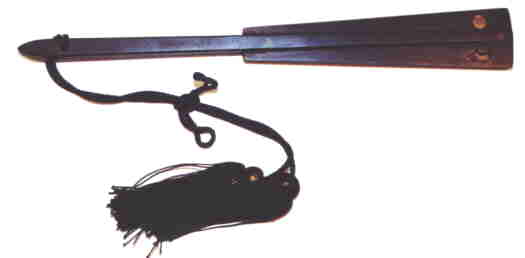| In
addition to the daisho, Japanese
samurai often carried many other specialized and easily
concealable weapons. These were used when otherwise unarmed
or, in some cases, when it was preferable not to kill or
seriously maim an attacker. The various martial arts ryuha
(schools) during the Tokugawa Era
frequently taught a wide range of specialized short arms
specifically designed for self-defense and which could be
hidden within everyday clothing.
Both samurai and
commoners alike considered the folding hand fan or sensu
an important accessory. Customarily carried in the hands
or tucked in the obi (belt), the folding fan also
played a significant role in Japanese etiquette, especially
on formal occasions, and was rarely ever out of a samurai's
possession.
Perhaps because
it was considered such an ordinary item, it was easily employed
as a suitable side arm with only minor modifications. These
weapons, called tessen, literally meaning "iron fan,"
were constructed of either an actual folding fan with metal
ribs or a non-folding solid bar of either iron or wood and
shaped like a folded fan. During the Edo Period, the tessen
was often considered a common self-defense weapon for extraordinary
situations.
There were many
situations in which a samurai would not have access to his
sword. For example, if visiting another person's home, especially
one belonging to a superior, a warrior was generally required
to leave one or both swords with an attendant at the door.
To prevent violence, obvious weapons such as swords, daggers,
and spears were also strictly prohibited within the small
confines of the pleasure districts such as Yoshiwara in
Edo. A tessen, though, was acceptable in any situation,
thus leaving the samurai always armed with at least one
very effective defensive weapon.

A tessen with iron outer ribs and bamboo
inner ribs made in the maiohgi-gata style.
Like the folding
fan, tessen usually had eight to ten bamboo or metal ribs
and could be worn with everyday attire. A solid tessen,
forged from iron or carved from hard wood to look like a
closed fan, was more durable and less expensive to make.
Perhaps for these reasons, the solid tessen were more popular
among samurai than the folding style.
There are many
recorded duels won using iron fans against naked swords
and even deaths caused by blows from a tessen. It was considered
unseemly for a bushi to use his sword against a lower-ranking
rival. On the other hand, tessen-jutsu was considered
sophisticated, especially among the higher-ranking samurai.
Thus, many trained in the defensive use of a tessen and
carried one at all times.
Tessen Styles
Like Japanese
hand fans, tessen were made in three basic shapes or styles.
Typically, the tessen were one shaku long, which is about
one-half inch more than a foot by modern standards. In general,
the three standard tessen shapes included:
 |
sensu-gata
- the basic folding fan
|
 |
maiohgi-gata
- the style used for traditional Japanese dancing
and in kabuki plays
|
 |
gunsen-gata
- the style used to control military troops during
war
|
|
|
Tessen,
which actually folded, were also referred to as menhari-gata.
These were made of metal ribs covered with silk or washi,
a very strong paper. The paper was often lacquered, reinforced
with gold or silver foil, or treated with oil to make it
both more decorative and less susceptible to weather damage.

A menhari-gata made in the sensu-gata style.
In some cases,
only the outside ribs were metal while the inside ribs were
made of the more flexible and lightweight bamboo strips.
The latter were less heavy and easier to carry than the
former, but were only effective as a self-defense implement
when closed. A folding tessen was not only effective as
a defensive weapon, but could be used as a regular hand
fan if necessary. Tessen was the term used most frequently
when referring to the folding style.
A folding tessen
was expensive to make and difficult to maintain, though.
Frequently tessen were solid iron cast in the shape of a
closed fan. This type was generally called tenarashi-gata
and was usually quite heavy. Some were made with straight
edges and only faintly resembled a hand fan while others
were more convincing replicas.

A tenarashi-gata made to appear as a closed
fan in the maiohgi-gata style.
Most samurai considered
tenarashi-gata much more effective in combat than the folding
style. This style of tessen also became quite popular with
both the samurai police officers and their non-samurai assistants.
Their disarming and arresting techniques often employed
a combination of tessen and jutte, the iron truncheon
they carried as a badge of office and as a weapon.
Solid style tessen
were also carved from hard wood such as sunuke or oak. Called
motsu-shaku, the solid wooden fan was fairly easy
and inexpensive to make. In comparison to the heavier iron
tessen, a motsu-shaku was also lighter and therefore easier
to carry. Samurai often used a motsu-shaku for self-protection
as well as for practice.
Tessen Decoration
Both the folding
and solid style often incorporated engravings of suitable
poems, rank titles, animal images, or symbolic kanji characters.
Sometimes a fancy silk cord wrapping was used as a handle,
almost like a bladed weapon. Of course, many tessen were
of a more sober and functional style, including little or
no decoration of any kind.
Tessen Practice
Although the practice
of tessen-jutsu was considered part of the classical Japanese
weapon arts, it was primarily intended for self-defense.
Tessen techniques were typically based on reactions for
self-protection rather than more aggressive strikes. Most
tessen-jutsu techniques are designed to incapacitate or
restrain an individual opponent rather than for inflicting
permanent injury or death.
|